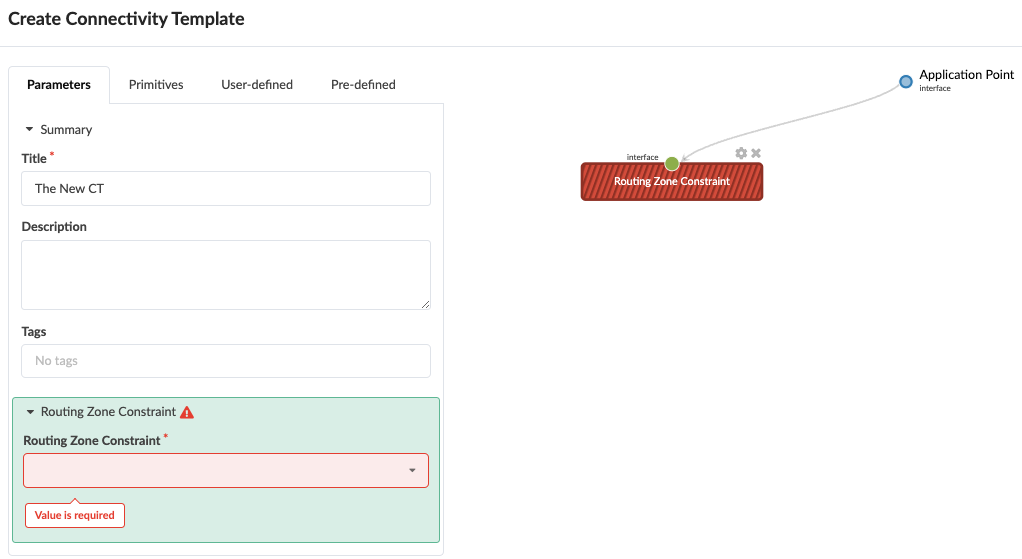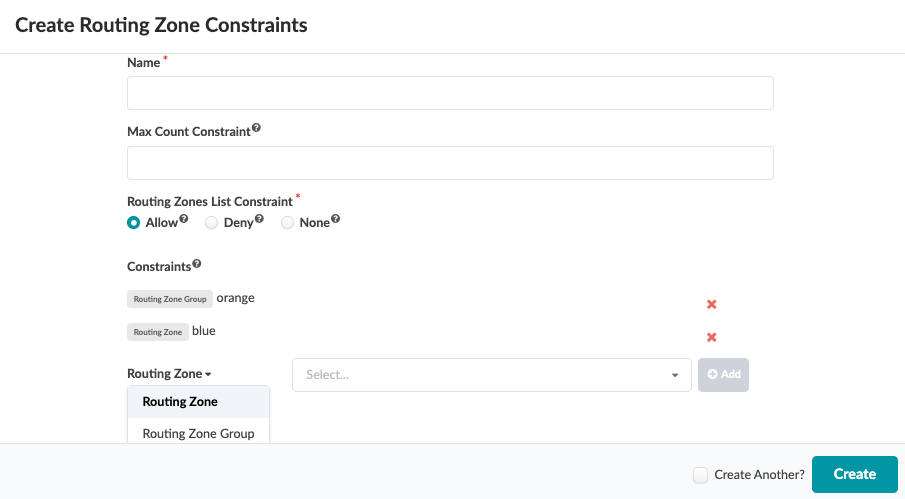- General Workflow
- play_arrow Apstra GUI
- play_arrow Design
- Logical Devices (Datacenter Design)
- Interface Maps (Datacenter Design)
- Rack Types (Datacenter Design)
- Templates (Datacenter Design)
- Config Templates (Freeform Design)
- play_arrow Configlets (Datacenter Design)
- play_arrow Property Sets (Datacenter Design)
- TCP/UDP Port Aliases (Datacenter Design)
- Tags (Design)
- play_arrow Devices
- Device Configuration Lifecycle
- play_arrow Managed Devices
- play_arrow System Agents
- play_arrow Pristine Configuration
- play_arrow Telemetry
- play_arrow Apstra ZTP
- play_arrow Resources Introduction
- play_arrow Freeform Reference Design
- Create / Delete Freeform Blueprint
- Freeform Blueprint Summary and Dashboard
- Topology (Freeform)
- play_arrow Systems (Freeform)
- Device Context (Freeform)
- play_arrow Links (Freeform)
- play_arrow Resource Management
- play_arrow Config Templates (Freeform Blueprint)
- Import Device Profile (Freeform)
- play_arrow Property Sets (Freeform Blueprints)
- play_arrow Tags (Freeform Blueprint)
- Tasks - Staged (Freeform)
- play_arrow Active
- Commit Blueprint
- Time Voyager
- play_arrow Analytics
- Configure Auto-Enabled Dashboards
- Instantiate Predefined Dashboard
- Create Analytics Dashboard
- Edit / Delete Dashboard
- Anomalies (Analytics)
- Widgets Overview
- Create Anomaly Heat Map Widget
- Create Stage Widget
- Edit / Delete Widget
- Probes
- Instantiate Predefined Probe
- Create Probe
- Import / Export Probe
- Edit / Delete Probe
- play_arrow Providers (External Systems)
- play_arrow Platform
- play_arrow User/Role Management (Platform)
- play_arrow Security (Platform)
- Syslog Configuration (Platform)
- Receivers (Platform)
- Global Statistics (Platform)
- Event Log (Platform)
- play_arrow Apstra VM Clusters
- play_arrow Developers (Platform)
- play_arrow Juniper Technical Support
- Favorites & User
- play_arrow Apstra Server Management
- Monitor Apstra Server via CLI
- Restart Apstra Server
- Reset Apstra Server VM Password
- Reinstall Apstra Server
- Apstra Database Overview
- Back up Apstra Database
- Restore Apstra Database
- Reset Apstra Database
- Migrate Apstra Database
- Replace SSL Certificate on Apstra Server with Signed One
- Replace SSL Certificate on Apstra Server with Self-Signed One
- Change Apstra Server Hostname
- Apstra CLI Utility
- play_arrow Guides
- play_arrow References
- play_arrow Apstra Feature Matrix
- Qualified Devices and NOS Versions
- NOS Upgrade Paths (Devices)
- play_arrow Predefined Dashboards (Analytics)
- Device Environmental Health Summary Dashboard (New in 4.1.2)
- Device Health Summary Dashboard
- Device Telemetry Health Summary Dashboard (New in 4.1.2)
- Drain Validation Dashboard
- Throughput Health MLAG Dashboard
- Traffic Trends Dashboard
- Virtual Infra Fabric Health Check Dashboard
- Virtual Infra Redundancy Check Dashboard
- play_arrow Predefined Probes (Analytics)
- BGP Session Flapping Probe
- Bandwidth Utilization Probe
- Critical Services: Utilization, Trending, Alerting Probe
- Device Environmental Checks Probe (New in 4.1.2)
- Device System Health Probe
- Device Telemetry Health Probe
- Device Traffic Probe
- Drain Traffic Anomaly Probe
- ECMP Imbalance (External Interfaces) Probe
- ECMP Imbalance (Fabric Interfaces) Probe
- ECMP Imbalance (Spine to Superspine Interfaces) Probe
- ESI Imbalance Probe
- EVPN Host Flapping Probe
- EVPN VXLAN Type-3 Route Validation Probe
- EVPN VXLAN Type-5 Route Validation Probe
- External Routes Probe
- Hot/Cold Interface Counters (Fabric Interfaces) Probe
- Hot/Cold Interface Counters (Specific Interfaces) Probe
- Hot/Cold Interface Counters (Spine to Superspine Interfaces) Probe
- Hypervisor and Fabric LAG Config Mismatch Probe (Virtual Infra)
- Hypervisor and Fabric VLAN Config Mismatch Probe (Virtual Infra)
- Hypervisor MTU Mismatch Probe (Virtual Infra NSX-T Only)
- Hypervisor MTU Threshold Check Probe (Virtual Infra)
- Hypervisor Missing LLDP Config Probe (Virtual Infra)
- Hypervisor Redundancy Checks Probe (Virtual Infra)
- Interface Flapping (Fabric Interfaces) Probe
- Interface Flapping (Specific Interfaces) Probe
- Interface Flapping (Specific Interfaces) Probe
- Interface Policy 802.1x Probe
- LAG Imbalance Probe
- Leafs Hosting Critical Services: Utilization, Trending, Alerting Probe
- Link Fault Tolerance in Leaf and Access LAGs Probe
- MLAG Imbalance Probe
- Multiagent Detector Probe
- Optical Transceivers Probe
- Packet Discard Percentage Probe
- Spine Fault Tolerance Probe
- Total East/West Traffic Probe
- VMs without Fabric Configured VLANs Probe (Virtual Infra)
- VXLAN Flood List Validation Probe
- play_arrow Probe Processors (Analytics)
- Processor: Accumulate
- Processor: Average
- Processor: Comparison
- Processor: EVPN Type 3
- Processor: EVPN Type 5
- Processor: Extensible Service Data Collector
- Processor: Generic Graph Collector
- Processor: Generic Service Data Collector
- Processor: Interface Counters
- Processor: Logical Operator
- Processor: Match Count
- Processor: Match Percentage
- Processor: Match String
- Processor: Max
- Processor: Min
- Processor: Periodic Average
- Processor: Range
- Processor: Ratio
- Processor: Service Data Collector
- Processor: Set Comparison
- Processor: Set Count
- Processor: Standard Deviation
- Processor: State
- Processor: Subtract
- Processor: Sum
- Processor: System Utilization
- Processor: Time in State
- Processor: Traffic Monitor
- Processor: Union
- Processor: VXLAN Floodlist
- Configlet Examples (Design)
- Apstra-CLI Commands
- Apstra EVPN Support Addendum
- Apstra Server Configuration File
- Agent Configuration File (Devices)
- Graph
- Juniper Apstra Technology Preview
Routing Zone (VRF) Constraints
Routing zone constraints allow you to constrain server-facing interfaces that connect to specific routing zones. Day-2 operators would be prevented from connecting a server to the wrong network, and assure that a given server never gets added to the wrong network. The constraint can be defined in various ways such as a list of allowed VRFs, a list of excluded VRFs, a maximum number of VRFs allowed, and so on. Once the constraint is defined, you can enforce the constraint on server-facing interfaces using connectivity templates of the type Routing Zone Constraint.
Create Routing Zone Groups (Optional)
If you want to constrain more than one routing zone to a single port, you can group them, then specify the group as a constraint when you create the routing zone constraint policy.
- From the blueprint, navigate to Staged > Virtual > Routing Zone Groups and click Create Routing Zone Group.
- Enter a group name and (optional) tags.
- In the Routing Zone drop-down list, select a routing zone to add to the group and click Add. The routing zone is added to the Members list.
- Repeat the previous step until you’ve added all the routing zones that you want in the group.
- Click Create to create the group and return to the table view.
Create Routing Zone Constraint Policy
- One VRF maximum
- Any VRF except Management
- Only VRFs Blue and Red
- Only VRF Group Orange
Edit / Delete Routing Zone Constraint Policy
If you need to, you can change or delete the policy after you've created it.
- If you edit the policy to increase the number of routing zones, you don't need to unassign participating ports from the restriction.
- If you edit the policy to reduce the number of routing zones, ensure that all participating ports are in compliance with the new restrictions before you save. Otherwise, you will receive an error.
- You can delete a constraint policy to free up any restrictions on the participating ports. These ports should behave as if the constraint was never applied.
Apply Routing Zone Constraint
When you want to apply the constraint to an application point, add the Routing
Zone Constraint primitive to the connectivity template and specify the
routing zone or routing zone group. For more information about connectivity
templates, see Connectivity
Templates. 























